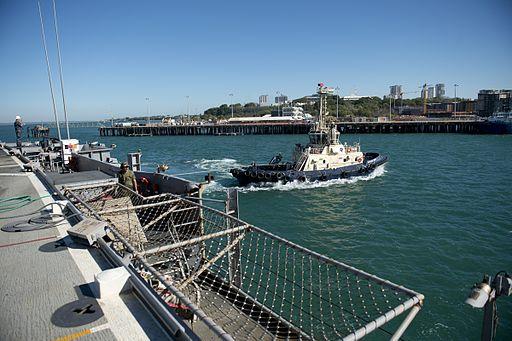 In March the US State Department dropped a line to the Australian people via The Australian newspaper to let us know how fearful we are of Chinese investment. To illustrate their point, they homed in on the deal that saw Chinese company, Landbridge, acquire an 80 percent share of the lease to operate the Port of Darwin.
In March the US State Department dropped a line to the Australian people via The Australian newspaper to let us know how fearful we are of Chinese investment. To illustrate their point, they homed in on the deal that saw Chinese company, Landbridge, acquire an 80 percent share of the lease to operate the Port of Darwin.
In the polling sponsored by the State Department, 43 percent of the public thought there was ‘a lot of risk’ to national security in the deal, while another 46 percent felt there was at least ‘some risk’. The poll’s sponsors concluded that this would ‘likely force Australians to rethink their choices of when to put national security ahead of economic gain’.
The intervention came in the middle of a Senate Inquiry into Australia’s foreign investment review processes as they relate to strategic assets.
But what exactly were the national security risks the public saw in the deal? And were these concerns unique to investment from China? According to The Australian newspaper coverage, the State Department didn’t ask.
We already knew from a 2014 Lowy Institute Poll that foreign investment in ‘airports and ports’ enjoys the lowest level of public support of any sector of the economy. To be clear: that’s foreign investment generally, not Chinese investment specifically.
Whether the public thinks that investment from China presents a unique risk, and how the public might trade off this risk against the economic benefits from Chinese investment, hasn’t been known. Until now.
In March 2016 research by academics at the Australia-China Relations Institute (ACRI) and the Centre for the Study of Choice at UTS surveyed a representative sample of 1000 Australians on attitudes towards foreign investment in maritime ports.
In contrast to traditional opinion polling, the study took a choice modelling approach. This means that respondents were presented with foreign investment scenarios that varied according to numerous characteristics such as where the investor was from, the percentage of foreign ownership that would result, whether the foreign company investing was government-owned or privately-owned, and so on.
Respondents were then asked to choose the scenarios they preferred the most and those they preferred the least. Based on this information, a model was constructed of how preferences are formed, revealing the most important drivers of public opinion.
The research found that the two biggest factors influencing public preferences were concerns around foreign ownership and control, not where the investors were from.
The number one factor was the share of foreign ownership in an investment deal.
Putting that finding in the context of the Darwin Port deal, the Northern Territory Government sold an 80 percent stake to Landbridge—so in line with this research, this is a likely reason for many Australians expressing concern.
The second most important factor in public opinion was the length of the lease. Given that the NT Government leased the Port of Darwin to Landbridge for a period of 99 years, it’s easy to understand why many Australians might take issue.
Does that mean Australians view infrastructure investment from China such as that in Darwin Port in the same way as investment from other countries?
Yes and no.
The research found that investor country-of-origin ranked as the third most important determinant of preferences, and the public preferred investment from the US to China. The US State Department would be pleased with this. But they might be disappointed to learn that the Australian public were no fonder of investment from democratic India than communist China.
They might also be disappointed to hear that the preference for US investors could readily be offset by other terms of an investment deal. For example, the modelling indicated that the public would actually prefer a port investment from China that resulted in 64 percent foreign ownership to one from the US that led to a 100 percent foreign share.
Alternatively, the model results also show that the Australian public would prefer an investment from China that resulted in 75 percent foreign ownership with a lease period of 80 years, than one from the US that led to 100 percent foreign ownership for 99 years. The point to underscore is that any public concerns about Chinese investors can be offset by other factors that are deemed more crucial, such as the share of ownership and length of the lease.
Despite data from KPMG and Sydney University showing a 59.5 percent increase in Chinese investment in Australia in 2015, the Australian Bureau of Statistics says that Australia’s total two-way investment stock with the US still outweighs that with China by more than 10 times. That means there’s plenty more potential in Australia’s investment relationship with China.
It also means there will be a continual, if not larger, debate about the implications of that investment relationship as it grows. Even before the Senate Inquiry presented its final report, the Australian Government made a number of changes in the foreign investment approvals process, albeit relatively modest ones. These include the requirement that investment in state and territory assets in critical infrastructure (including marine ports) now be subject to FIRB scrutiny.
The Senate Inquiry gave voice to all manner of views on foreign investment and it’s important to have such public platforms that encourage diverse discussion.
Some argue that increased Chinese investment might be detrimental to Australian national security or even harm the ANZUS alliance. Others say it’s an economic imperative.To find out what the public really thinks about tapping that potential, it helps to ask the right questions.